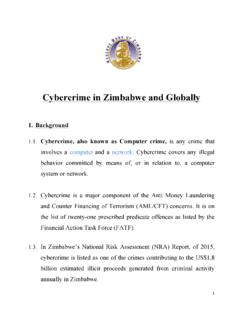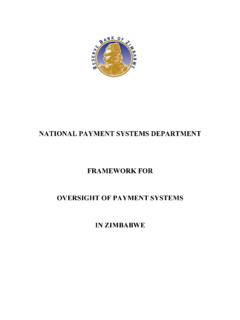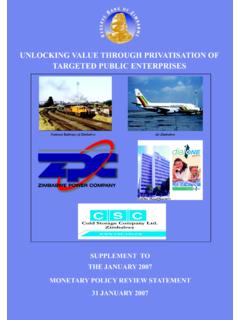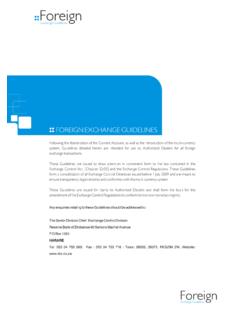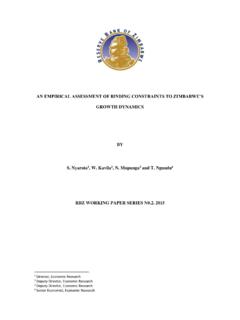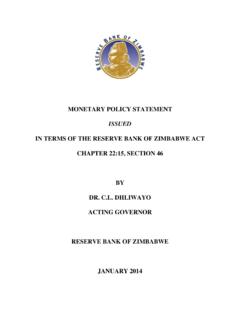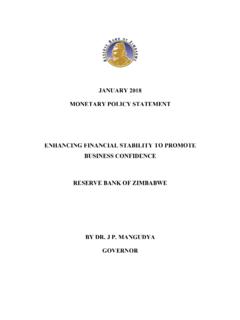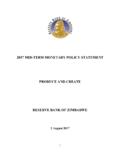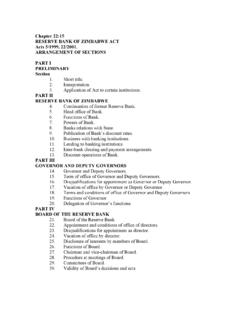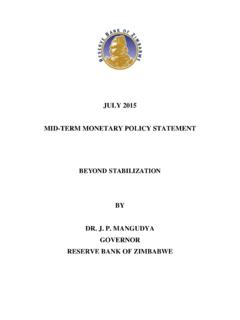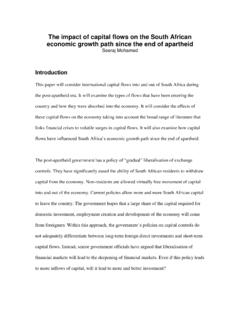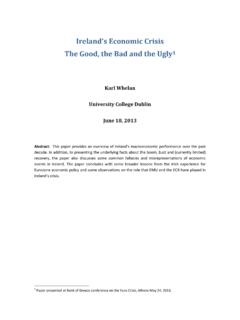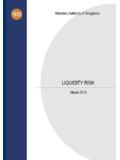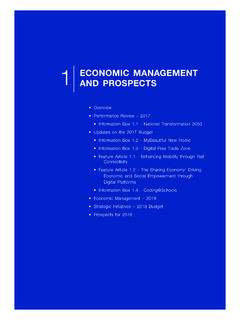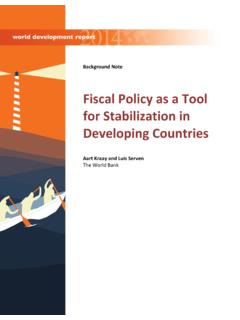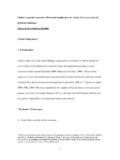Transcription of ECONOMIC RESEARCH DEPARTMENT RBZ …
1 ASSESSING THE impact OF THE REAL EFFECTIVE EXCHANGE RATE ON COMPETITIVENESS IN ZIMBABWE By ECONOMIC RESEARCH DEPARTMENT RBZ working paper SERIES No 1-2015 2015 2 ABSTRACT This paper attempts to estimate the equilibrium real effective exchange rate for Zimbabwe, with a view to determine the level of adjustment required to attain both internal and external balance. The macro-balance approach which is a standard model used by the International Monetary Fund (IMF) to assess equilibrium exchange rates was applied to estimate the medium-term value of the exchange rate that is consistent with internal and external balance. Based on the calibrated current account balance to the Gross Domestic Product (GDP) norm of 11 percent and exchange rate elasticity with respect to current account of , the analysis found that the real effective exchange rate would need to depreciate by about 45 percent to eliminate the disparity between the current account norm and the medium term current account forecast.
2 However, given the lack of policy autonomy on the exchange rate front to undertake external devaluation, the disparity can only be removed through a fiscal or an internal devaluation process. Fiscal devaluation measures entail reducing taxes on labour and increasing value added tax on imported products, while internal devaluation can be achieved through relative price changes and improvement in productivity. This entails removing structural bottlenecks in the economy and promoting investment in infrastructure to reduce the cost of doing business. The policy implication is the need for Government to come up with strategies for undertaking fiscal and internal devaluation to eliminate the competitiveness challenges caused by the real effective exchange rate overvaluation.
3 KEYWORDS: External Balance, Real Effective Exchange Rate, Macroeconomic Balance Approach JEL: F31, F41, E65 Disclaimer: The views and conclusions expressed in this paper are those of the authors and do not necessarily reflect the official position of the Reserve Bank of Zimbabwe. For more information concerning the paper do not hesitate to contact the Director, ECONOMIC RESEARCH , Mr. Simon. Nyarota, email address: 3 Table of Contents ABSTRACT .. 2 SECTION ONE: INTRODUCTION .. 3 SECTION TWO: TRENDS IN ZIMBABWE S COMPETITIVENESS INDICATORS .. 6 Real Exchange Rate .. 6 Trade Developments .. 8 Non-Price Factors of Competitiveness .. 11 SECTION THREE: LITERATURE REVIEW .. 13 Theoretical Literature .. 13 Empirical Literature .. 16 SECTION FOUR: METHODOLOGY.
4 18 Justification of Variables .. 19 Data Sources and Estimation .. 20 SECTION FIVE: ESTIMATION RESULTS AND ANALYSIS .. 21 Estimated Current Account Elasticity .. 22 SECTION SIX: CONCLUSION AND POLICY RECOMMENDATIONS .. 27 REFERENCES .. 30 List of Tables Table 1: Composition of Exports in 1990 and 9 Table 2: Regional and International Trade Shares for 2013 & 11 Table 3: Global Competitiveness Index for Selected SADC Countries .. 12 Table 4: Ease of Doing Business Index .. 12 Table 5: Macroeconomic Balance Estimation (CAB/GDP Dependant Variable) .. 21 Table 6: Current account elasticity computations .. 23 List of Figures Figure 1: Implied Real Effective Exchange Rates and Nominal Effective Exchange rates (Jan 2009 =100) .. 7 Figure 2: Merchandise Exports and Imports: 1990 to 2014 (US$m).
5 8 Figure 3: Major Export Markets 2013 & 2014 (%) .. 9 Figure 4: Import Sources 2013 & 2014 (%) .. 10 Figure 5: Current account balance norm and underlying current account balance .. 24 Figure 6: Estimated Reel Effective Exchange Rate Gap (2000-2015) .. 25 Figure 7: Comparisons of Results with Initial CGER Coefficients .. 26 4 SECTION ONE: INTRODUCTION The adoption of multiple currencies in the aftermath of episodes of hyperinflation saw ECONOMIC activity rebounding on the back of an improved business environment. In this regard, industrial capacity utilization improved from estimated levels of less than 10% in 2008 to in 2012 on the back of relative price stability. Benefitting from improved industrial capacity utilization, Gross Domestic Product (GDP) which had cumulatively declined by an estimated 50% over the period 2000 to 2008, rebounded to an overage of over the period 2009 to 2012.
6 In concomitance with revival in ECONOMIC activity, export performance improved markedly from US$ billion in 2008 to US$ billion in 2011 before declining to US$ billion in 2014. The decline in export performance particularly on the back of a relatively high import bill has ignited debate on the impact of the appreciation of the US$ on the competitiveness of the country s products in both the domestic and export markets. The progressive appreciation of the US$ against major trading partner currencies particularly the South African Rand, has prompted a review of the suitability of the continued use of the US$ as the anchor currency in Zimbabwe s basket of multiple currencies. This topical subject has prompted a rethink in terms of the need to establish an exchange rate threshold beyond which the continued appreciation of the US$ will significantly dent ECONOMIC growth prospects in Zimbabwe.
7 Notwithstanding the negative year on year inflation experienced in Zimbabwe over past few months, the implied real effective exchange rate computed using the US$ exchange rate against Zimbabwe s major trading partners adjusted for inflation has sustainably appreciated, reflecting further loss of competitiveness. These adverse exchange rate developments have occurred in a multiple currency environment that has largely been typified by lack of exchange rate and interest rate policy tools to correct both internal and external imbalances. As such, in the absence of nominal exchange rate devaluation to enhance export competitiveness, alternative policies of fiscal or internal devaluation may be explored to mimic the expenditure-switching effects of exchange rate devaluation.
8 Fiscal devaluation entails reducing taxes on labour and increasing value added tax on imported products. Internal devaluation measures reduces domestic prices either by affecting relative export-import prices or by lowering domestic production costs, thereby, reversing the appreciation in the real exchange rate. 5 On the back of Zimbabwe s strong trade and investment ties, the appreciation of the US$ against the South African rand has adverse effects on the competitiveness of the country s exports in South Africa. On the other hand, the weakening of the Rand, has also made imports from South Africa relatively cheaper on the domestic market. The weakening of the Rand against the US$ has had negative effects on the country s trade balance and the overall balance of payments at large.
9 In view of the country s high import dependence occasioned by attendant supply gaps, liquidity conditions have further tightened and foreign exchange reserve buffers have remained depleted. Notably, the country has realized persistent current account deficits which have averaged more than 20% of GDP since the introduction of multiple currencies, a development that is attributed to underlying competitiveness challenges. Against the background of these competitiveness challenges, the volume of manufactured exports has declined progressively since 2011. Further, the dominance of mining and agriculture commodities in the export basket also brings to the fore, the lack of competitiveness in the country s manufacturing sector.
10 In addition, the influx of imports, particularly finished retail products from South Africa and the Far East, has lent credence to the view that the competitiveness of the country s manufacturing sector has remained compromised. In the same context, high share of consumption goods in total imports suggests that the real effective exchange rate may be overvalued (IMF, 2014). Similarly, survey-based indicators of competitiveness, governance, corruption and business environment also confirm the country s lack of competitiveness. Recent reviews of non-price factors such as the World Bank Ease of Doing Business and the World ECONOMIC Forum s Global Competitiveness Index show that Zimbabwe s ranking compares unfavourably with its regional peers.
